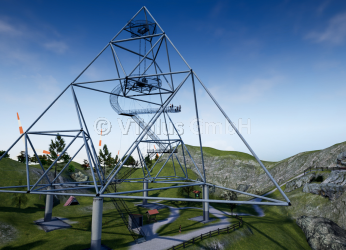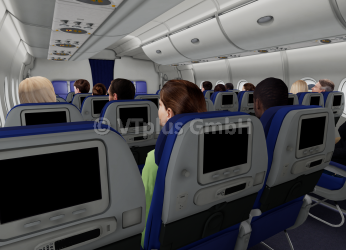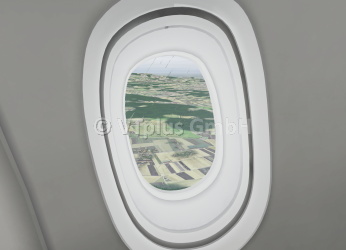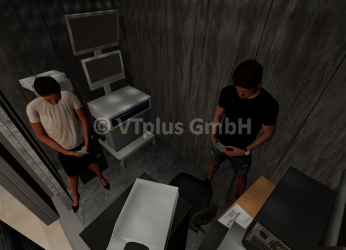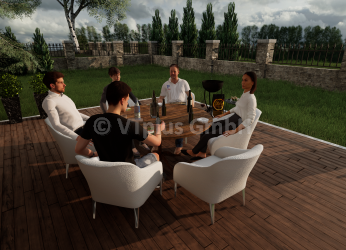Exposure exercises with virtual reality
Virtual Reality allows to practice the dealing with anxiety triggering situations in a protected environment. Through confrontation with anxiety in virtual reality, patients can experience in the course of therapy that the feared consequences do not occur and that they can deal with their fear. The effectiveness of anxiety exposure in virtual reality, also known as Virtual Reality Exposure Therapy (VRET), has already been demonstrated in a large number of studies (see publications). The safety of VRET has also been investigated in a study published in the Journal of Anxiety Disorders. The authors show that worsening of symptoms with a VRET is less frequent than with a placebo group and side effects are rare. The S3 guideline for the treatment of anxiety disorders › recommends exposure exercises in virtual reality for the treatment of specific phobias when in vivo exposure is not available or possible. A selection of treatment facilities that already use virtual reality and a selection of available virtual situations (exposure scenarios) are listed below
Exposure Scenarios
Fear Of Heights
People with fear of heights can practice dealing with height situations during an exposure in virtual reality. Despite negative feelings (e.g. fear, dizziness, insecurity, feelings of anxiety), people are able to move safely through the elevation situations (i.e. without losing their footing or falling). Through this experience people with fear of heights learn how to deal with height situations and develop a self-efficacy when searching for new height situations.
Fear Of Flying
When suffering from fear of flying, flights are completely avoided or only survived under great fear. Fear of flying therapy in virtual reality offers the possibility to practice dealing with negative feelings (e.g. palpitations, sweating) and thoughts (e.g. plane crash) before and during a flight. During the confrontation therapy it is learned that automatically occurring negative reactions to fear of flying are no sign that something will happen during a flight.
Animal Phobia – Birds
Animal phobia is a specific phobia that refers to living beings. Here the affected person suffers from the fear of the respective animal, although he has learned that the animal is harmless. Symptoms range from mild discomfort to panic. A typical symptom of animal phobia is fear of expectations and avoidance as a coping strategy. With virtual reality there is the possibility to recreate frightening situations and living beings and to gradually reduce fear by careful exposure.
Animal Phobia – Spiders
During confrontation exercises against fear of spiders in virtual reality, patients experience that the unpleasant reactions to exposure to a spider (e.g. intense fear, palpitations, sweating, disgust) do not increase to the immeasurable, but automatically subside after a certain time. The gradual approach to spiders and the repeated experience of the decline in anxiety leads to a learning process in the brain, as a result of which situations with spiders cause less and less fear.
Social Anxiety – Presentation / Application / Office Situations
Social situations, such as giving a presentation, a job interview or getting to know new colleagues, can be accompanied by unpleasant reactions (e.g. racing heart, sweating, anxiety, fear of being judged negatively). During a confrontation therapy in virtual reality, the handling of such situations and the thoughts and feelings arising from them can be practiced. By specifically seeking out the dreaded situations, corrective experiences can be made (e.g. feelings of anxiety diminish over time, a lecture can be given in spite of fear), which leads to a long-term decrease in anxiety.
Claustrophobia
People with claustrophobia can practice dealing with confined spaces, such as elevators or basements, during an exposure in virtual reality. By enduring the negative situations in the virtual world persons can learn to master such situations in reality. Various rooms and levels of anxiety-inducing stimuli are available.
Nicotine Addiction
Nicotine addicts who want to quit smoking are especially challenged in social situations. In order to train to actively refuse cigarettes offered in such a situation, a discussion round is available in both a private and public environment, in which cigarettes are frequently offered.
Treatment Facilities
Among others locations, Virtual Reality (VT+Exposure Systems › and VT+VR-Research-Systems › ) is used in psychotherapeutic research as well as a supportive treatment at the following locations.
The Central Institute of Mental Health (ZI-Mannheim) stands for internationally outstanding research and pioneering treatment concepts in psychiatry and psychotherapy, child and adolescent psychiatry, psychosomatic medicine and addiction medicine.
In case of fears of heights, spiders and/or narrow spaces, the ZI offers, according to individual needs, an initial consultation on your fears and strains an in-depth psychological examination an outpatient psychotherapy (cognitive-behavioural-therapeutic oriented psychotherapy, usually twelve sessions). If fear of heights, spiders and/or narrow spaces determines your daily life, an exposure therapy can be helpful. A new treatment offer at the ZI in Mannheim uses virtual reality in combination with outpatient psychotherapy. Those affected can confront their fears with the help of VR glasses.
Further information and contact details ›
The goal of the Mühlenkreiskliniken is to ensure and expand the stationary medical care of people in the Minden-Lübbecke district and beyond. The Medical Center for Mental Health supplies the district Minden-Lübbecke and the adjacent regions.
The University Clinic for Psychiatry and Psychotherapy in the Medical Center for Mental Health in Lübbecke is the only institution also beyond the region of East Westphalia to have a facility that offers patients the opportunity to immerse themselves in virtual realities and thereby overcome their fears.
Further Information › and contact details ›
The Outpatient Center under the direction of Prof. Dr. Dr. Ulrich Sprick offers a comprehensive range of consultation, diagnosis and therapy for people with mental illness and disorders. At the outpatient center, virtual reality with 3D glasses for the therapy of specific anxieties is currently being incorporated into outpatient care.
Further information › and contact details ›
Psychosomatic Day Clinic of the Clinic and Polyclinic for Psychiatry, Psychosomatics and Psychotherapy of the University Hospital Würzburg
The part-time inpatient treatment at the psychosomatic day clinic is aimed at adult patients whose mental stress or illness leads to physical symptoms or who are seriously ill and therefore require psychiatric support. The individually tailored treatment concept is based on a combination of depth psychology and cognitive behavioral therapy. In individual and group therapies, we emphasize a so-called resource-oriented perspective that uncovers and strengthens existing abilities.
Further information › and contact details ›
The university outpatient clinic for psychotherapy at the University of Würzburg uses virtual reality for exposure therapy and for research purposes. Among other things, anxiety treatments are offered and, in particular, a movement simulator is used in cases of fear of flying. Furthermore, a block therapy for the treatment of car driving anxiety is offered with the program “Fahrangst kompakt”. Further information and contact details ›
At the Chair of Clinical Psychology and Psychotherapy at the University of Regensburg, Virtual Reality is used to optimize empirical research in the fields of clinical psychology, psychotherapy and safety research. Controlled empirical studies are conducted with the help of VT+ Virtual Reality research systems using both proprietary and specially developed virtual environments.
Contact details ›
The Institute Outpatient Clinic for Psychotherapy of the TU Dresden› interlocks research and therapy of mental disorders. The Special Outpatient Clinic for Anxiety Disorders (Protect-AD) aims to provide intensive treatment for anxiety disorders as soon as possible. The treatment is shorter and more intensive than usual, a noticeable improvement for the patient and his living environment is accordingly faster achieved. Their research is funded by the German Federal Ministry of Education and Research, which makes participation possible with almost no waiting time.
Further information and contact details ›
Patient Information
Some of the listed therapeutic institutions carry out scientific investigations and study therapies in the field of psychotherapy research in addition to their governmental commissions for outpatient psychotherapy, therapy training.
To clarify whether your symptoms are an anxiety disorder and which therapy options are available, please contact the admissions department of the respective outpatient clinic.
Information for treatment facilities
Market-leading manufacturer of highly integrated exposure systems with virtual reality for confrontation and behavioral exercises for stationary or ambulant therapeutic facilities is VTplus GmbH ›. Further information on application possibilities, acquisition costs and contact details can be found on the product page: VT+ Exposure System with Virtual Reality ›.
Publications
Herrmann, M., Katzorke, A., Busch, Y., Gromer, D., Polak, T., Pauli, P. & Deckert, J. (2017). Medial prefrontal cortex stimulation accelerates therapy response of exposure therapy in acrophobia. Brain Stimulation, Volume 10, Issue 2, Pages 291-297. doi: 10.1016/j.brs.2016.11.007
Shiban, Y., Diemer, J., Müller, J., Brütting-Schick, J., Pauli, P. & Mühlberger, A. (2017). Diaphragmatic breathing during virtual reality exposure therapy for aviophobia: functional coping strategy or avoidance behavior? a pilot study. BMC Psychiatry, 17:29. doi: 10.1186/s12888-016-1181-2
Peperkorn, H. M., Diemer, J. E., Alpers, G. W., & Mühlberger, A. (2016). Representation of patients’ hand modulates fear reactions of patients with spider phobia in virtual reality. Frontiers in psychology, 7, 268. doi: 10.3389/fpsyg.2016.00268
Shiban, Y., Peperkorn, H., Alpers, G., Pauli, P. & Mühlberger, A. (2016). Influence of perceptual cues and conceptual information on the activation and reduction of claustrophobic fear. Journal of Behavior Therapy and Experimental Psychiatry.(2016) Volume 51, Pages 19-26. doi: 10.1016/j.jbtep.2015.11.002
Peperkorn, H. M., Alpers, G. W., & Mühlberger, A. (2014). Triggers of fear: perceptual cues versus conceptual information in spider phobia. Journal of clinical psychology, 70(7), 704-714. doi: 10.1002/jclp.22057
Diemer, J., Domschke, K., Mühlberger, A., Winter, B., Zavorotnyy, M., Notzon, S., Silling, K., Arolt, V. and Zwanzger, P. (2013). Acute anxiolytic effects of quetiapine during virtual reality exposure—A double-blind placebo– controlled trial in patients with specific phobia. European Neuropsychopharmacology, 23, 1551– 1560. doi: 10.1016/j.euroneuro.2013.01.001
Shiban, Y., Pauli, P., & Mühlberger, A. (2013). Effect of multiple context exposure on renewal in spider phobia. Behaviour Research and Therapy, 51, 68-74. DOI: 10.1016/j.brat.2012.10.007
Mühlberger, A., Sperber, M., Wieser, M. J., Pauli, P. (2008). A virtual reality behavior avoidance test (VR-BAT) for the assessment of spider phobia. Journal of CyberTherapy & Rehabilitation 1,2.
Mühlberger, A., Weik, A., Pauli, P. & Wiedemann, G. (2006). One-session virtual reality exposure treatment for fear of flying: one year follow-up and graduation flight accompaniment effects.Psychotherapy Research. 16, 26-40.
Mühlberger, A., Petrusek, S., Herrmann, M. J. & Pauli, P. (2005). Biocyberpsychologie: Subjektive und physiologische Reaktionen von Flugphobikern und Gesunden bei Exposition mit virtuellen Flügen [Biocyber psychology: subjective and physiological reactions in flight phobics and normal subjects during flight simulations]. Zeitschrift für Klinische Psychologie und Psychotherapie. 34, 133-143.
Mühlberger, A., Wiedemann, G. & Pauli, P. (2005). Subjective and physiologic reactions of flight phobics during VR exposure and treatment outcome: What adds motion simulation? Annual Review of CyberTherapy and Telemedicine: A decade of VR, 3, 185-192.
Mühlberger, A., Wiedemann, G. and Pauli, P. (2003). Efficacy of a one-session virtual reality exposure treatment for fear of flying. Psychotherapy Research, 13(3), 323-336.
Mühlberger, A., Herrmann, M. J., Wiedemann, G., Ellgring, H. & Pauli, P. (2001). Repeated exposure of flight phobics to flights in virtual reality. Behaviour Research and Therapy, 39, 1033-1050.
Meta-Analysis
Fernández-Álvarez, J., Rozental, A. , Carlbring, P. , Colombo D. , Riva, G. , L. Anderson, P. , María Baños, R. , A. Benbow A. , Bouchard, S. , María Bretón López, J., Cárdenas, G. , Difede J., Emmelkamp P., García-Palacios, A. , Guillén, V. , Hoffman, H. , Kampann, I., Moldovan, R., Mühlberger, A. , North, M. , Pauli, P., Peñate Castro, W., Quero, S., Tortella-Feliu, M., Wyka, K., Botella, C., (2018). Deterioration rates in Virtual Reality Therapy: An individual patient data level meta-analysis. Journal of Anxiety Disorders. doi: 10.1016/j.janxdis.2018.06.005
Gregg, L., & Tarrier, N. (2007). Virtual reality in mental health: A review of the literature. Social Psychiatry and Psychiatric Epidemiology, 42(5), 343–354. doi: 10.1007/s00127-007-0173-4
Morina, N., Ijntema, H., Meyerbröker, K., & Emmelkamp, P. M. G. (2015). Can virtual reality exposure therapy gains be generalized to real-life? A meta-analysis of studies applying behavioral assessments. Behaviour Research and Therapy, 74, 18–24. doi: 10.1016/j.brat.2015.08.010
Opriş, D., Pintea, S., García-Palacios, A., Botella, C., Szamosközi, Ş., & David, D. (2012a). Virtual reality exposure therapy in anxiety disorders: A quantitative meta-analysis. Depression and Anxiety, 29(2), 85–93. doi: 10.1002/da.20910
Parsons, T. D., & Rizzo, A. A. (2008a). Affective outcomes of virtual reality exposure therapy for anxiety and specific phobias: A meta-analysis. Journal of Behavior Therapy and Experimental Psychiatry, 39(3), 250–261. doi: 10.1016/j.jbtep.2007.07.007
Powers, M. B., & Emmelkamp, P. M. G. (2008). Virtual reality exposure therapy for anxiety disorders: A meta-analysis. Journal of Anxiety Disorders, 22(3), 561–569. doi: 10.1016/j.janxdis.2007.04.006
Overview Article
Diemer, J., Zwanzger, P. Die Entwicklung virtueller Realität als Expositionsverfahren. Nervenarzt 90, 715–723 (2019). doi: 10.1007/s00115-019-0678-6
Shiban, Y. Virtuelle Expositionstherapie bei Angststörungen. Nervenarzt 89, 1227–1231 (2018). doi: 10.1007/s00115-018-0596-z

